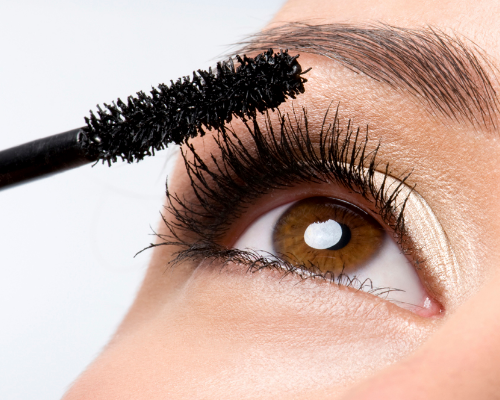Originally quoted from The Beauty Isle Insider by
The Creators of The Beauty Brains

~Image from: Makeup Geek~
What's in mascara and how does it work? Here's the science-y scoop.
History of Mascara
First, a quick bit of background. we know that mascaras have been around since at least 4000 BC because historical records show that Egyptians used charcoal and other minerals to darken their lashes and eyelids. In modern times, mascara first appeared in the form of a pressed cake that was applied by wetting a brush, rubbing it on the cake and then applying it to eyelashes. The cake consisted of a mixture of black pigments and soap chips.The next innovation in mascara involved a lotion-like version of the soap cake that was packaged in a tube and squeezed onto a small brush to apply. Mascara as we know it today was created in the 1960s with the invention of a grooved brush that could apply a consistent amount of the pigment. This is the basic form that's still used today.
Common Ingredients
The primary ingredients in mascara are pigments — the chemicals that provide colors. Because U.S. federal regulations only allow certain colorants to be used in the area of the eye, only natural colors and inorganic pigments are used. Carbon black and iron oxide provides black, brown and red colors; ultramarine blue provides blue and green shades. These pigments are mixed together in a cosmetic base that is an emulsion of oils, waxes and water. For example of these waxy ingredients, let's look at the ingredients list from Maybelline Great Lash:water, beeswax, ozokerite, shellac,
glyceryl stearate, triethanolamine,
propylene glycol, stearic acid, sorbitan
sesquioleate, methylparaben, quaternium-15,
quaternium-22, simethicone, butylparaben,
iron oxides (may contai), titanium dioxide
(may contain), ultramarine blue
The beexwax, ozokerite, stearic acid and shellac provide the main body of the mascara and give it it's waterproof and smudgeproof properties. Glyceryl stearate and triethanolamine are added to make sure the mascara can be washed off. The propylene glycol, sorbitan sesquioleate and simethicone, added as processing agents, help control the consistency of the product while methylparaben, quaternium-15, quaternium-22 and butylparaben are preservatives that keep the mascara free of "bugs". Finally, the iron oxides, titanium dioxide and ultramarine blue are the pigments.
 Hello. My name is Riih Rion Pu Niao and I am a female blogger. I blog mainly about my personal opinions on beauty products, links to get free samples (in Singapore), monthly beauty topic(s) and other goodies related to beauty topics on this blog. What started out as curiosity back in April 2007 soon turned into serious blogging-mania for me.
Note that all photos featured in this blog are concentrated on the products itself, and I personally do not believe in trying to wrestle attention away from the products by constantly squeezing my mugshot in it. Photos are mostly and currently taken with a Canon Ixus 170 & Samsung Galaxy S7 and edited with Paint.Net & Giphy.
You can read more about me and this blog by exploring the links above.
For those of you who are unable to comment on Blogger, you can still make comments on my
Hello. My name is Riih Rion Pu Niao and I am a female blogger. I blog mainly about my personal opinions on beauty products, links to get free samples (in Singapore), monthly beauty topic(s) and other goodies related to beauty topics on this blog. What started out as curiosity back in April 2007 soon turned into serious blogging-mania for me.
Note that all photos featured in this blog are concentrated on the products itself, and I personally do not believe in trying to wrestle attention away from the products by constantly squeezing my mugshot in it. Photos are mostly and currently taken with a Canon Ixus 170 & Samsung Galaxy S7 and edited with Paint.Net & Giphy.
You can read more about me and this blog by exploring the links above.
For those of you who are unable to comment on Blogger, you can still make comments on my 




0 comments:
Post a Comment
Thank you for commenting on Pu Niao's Beauty Junkie Reviews, a personal blog on Beauty-related stuffs. Kindly note that I will reciprocate as soon as I possibly can, unless:
1. I'm not online (probably dead asleep and possibly drooling)
2. Got blindsided by free candy (where did that came from?)
3. Cannot find your comment box cos I am actually blind as a bat most times (-squints- *_* -blinks-)
Rules:
1. Kindly avoid promotional/non-sense/unrelated comments or demands as this can be reason for deletion of your comments.
2. Avoid commenting with "nice post"/"thanks for sharing", or the likes. Kindly just read the post and comment something about it.
3. Replying with some facts/rumors or other info related to the post is well appreciated too.
Your comments always make my day(s) feel special and appreciated and each comment will be followed up as well. Thank you and have a wonderful day ahead~